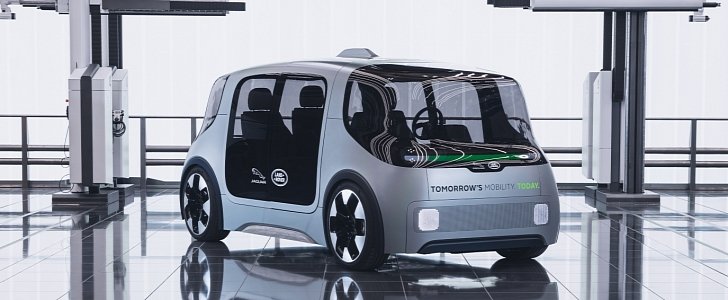Jaguar Land Rover is jumping on the “mobility” bandwagon with Project Vector, a bus-type of electric, self-driving vehicle that aims to make everything better.
Project Vector is bold and innovative, and unlike anything else we’ve seen from the Jaguar or Land Rover lineups. At the same time, it feels generic when compared to other concepts from other marques that have started their foray into urban mobility and last-mile possibilities: an electric, self-driving pod with seats facing each other, and plenty of screens and connectivity options.
The JLR Vector fits in just perfectly with the Destination Zero program, which aims to offer concrete, efficient solutions to urban mobility problems, while also showing due care for the environment and, ultimately, people’s health. It is fully-electric, fully connected and fully autonomous (“autonomy-ready,” as the press release puts it), and comes with plenty of interior space that renders it highly customizable and functional.
“Jaguar Land Rover understands the trends shaping modern societies. Project Vector shows Jaguar Land Rover as a leader in innovation to make our societies safer and healthier, and the environment cleaner,” Jaguar Land Rover Chief Executive Officer, Prof Sir Ralf Speth, said at the unveil on February 18. “Through this project, we are collaborating with the brightest minds in academia, supply chain and digital services, to create connected, integrated mobility systems – the fundamental building blocks for Destination Zero.”
Measuring 4 meters in length, Project Vector packs the battery and drivetrain underneath the flat floor, which opens up the space to a variety of configurations, from private to shared use or commercial application. This makes it suitable for a variety of uses, but the focus would probably fall on last-mile deliveries and shared mobility.
“The megatrends of urbanization and digitalization make connected urban mobility systems necessary and inevitable,” Dr. Tim Leverton, Project Director, explains. “Shared and private vehicles will share spaces with and be connected to public transit networks, so you can travel on demand and autonomously. That is a complex task, best achieved by working together with partners across the spectrum of vehicles, infrastructure and the digital world.”
Jaguar Land Rover will work with the West Midlands Combined Authority and Coventry City Council on a mobility service from late 2021, bringing Project Vector into the realm of reality.
The JLR Vector fits in just perfectly with the Destination Zero program, which aims to offer concrete, efficient solutions to urban mobility problems, while also showing due care for the environment and, ultimately, people’s health. It is fully-electric, fully connected and fully autonomous (“autonomy-ready,” as the press release puts it), and comes with plenty of interior space that renders it highly customizable and functional.
“Jaguar Land Rover understands the trends shaping modern societies. Project Vector shows Jaguar Land Rover as a leader in innovation to make our societies safer and healthier, and the environment cleaner,” Jaguar Land Rover Chief Executive Officer, Prof Sir Ralf Speth, said at the unveil on February 18. “Through this project, we are collaborating with the brightest minds in academia, supply chain and digital services, to create connected, integrated mobility systems – the fundamental building blocks for Destination Zero.”
Measuring 4 meters in length, Project Vector packs the battery and drivetrain underneath the flat floor, which opens up the space to a variety of configurations, from private to shared use or commercial application. This makes it suitable for a variety of uses, but the focus would probably fall on last-mile deliveries and shared mobility.
“The megatrends of urbanization and digitalization make connected urban mobility systems necessary and inevitable,” Dr. Tim Leverton, Project Director, explains. “Shared and private vehicles will share spaces with and be connected to public transit networks, so you can travel on demand and autonomously. That is a complex task, best achieved by working together with partners across the spectrum of vehicles, infrastructure and the digital world.”
Jaguar Land Rover will work with the West Midlands Combined Authority and Coventry City Council on a mobility service from late 2021, bringing Project Vector into the realm of reality.







